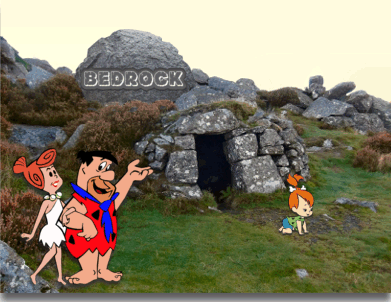
The next stage of the tramway runs from the first set of points at the Haytor Quarries down to Holwell Quarry which is a distance of 0.75 miles (1.2km). As can be seen below there is a wicked incline as the route drops down to the quarry, all in all there is an ascent of 52.6 feet (16m) but a descent of -82.5 feet (-26.9m).

The actual quarry is located on the north side of Holwell Tor which is sometimes locally known as Ovals Tor and likewise the quarry as Ovals Quarry. This was the second largest of the Haytor Quarries and was being worked from at least 1820 through to 1840. Holwell Quarry consists of two large extraction sites and a smaller pit all served by the tramway in one form or another. The first thing to greet you is another set of points at the top of the incline down to the quarry, these again are well preserved and would have been used for diverting the wagons onto and off of the main line. As you follow the descent down to the quarry you can’t help pondering a couple of things, firstly try imagining the horses pulling wagons up that slope. Bearing in mind that each ‘train’ may well consist of 12 wagons each loaded with around 3 tons of granite making for a combined load weight of 36 tons. Ewans, p.24, records two local rhymes, but remember that Holwell was also known as Ovals and the word tor pronounced in the local dialect would be ‘tar’:
1) Nineteen stout horses it was known
From Holwell Quarry drew the stone,
And mounted on a twelve wheeled car
‘Twas safely brought from Holwell Tor.
2) Eighteen brave steed and twelve old car
To take stone from Ovals Tor;
The stallion in front they did place
It was John Murrin’s, of Teigngrace.
Once a wagon train had been hailed up the slope the empty wagons and horses needed to be returned to the bottom. One local theory was that the horses would have been loaded onto some kind of special wagon but this seems unlikely as trying to keep so many horses calm would be nearly impossible. Therefore it is probable that the wagons where rolled down using the flimsy braking system and a brakesman and the horses led down separately.
The second to ponder on lies on the left-hand side of the track going down, just below a small holly tree on the right-hand side. It is the broken remains of what was intended to be a cider pound, used for pulping the apples, this serves as a reminder that not just square granite blocks came from the quarries. In fact there are other such semi finished artefacts dotted around the area and others include granite troughs.

The big difference to be seen here is the near vertical rock faces which in places are around 20m in height. In the eastern quarry is plenty of evidence where the shot holes were drilled before blasting took place along with waste scattered everywhere. The spoil ( both rock and overburden) from all the three Holwell quarries was deposited to the north of the tor, in comparison to the finger dumps at Haytor quarry these are much taller, flatter and rounded. There are four stone sets that diverge from the main tramline and would have carried the waste to the spoil heaps There are the remnants of five buildings at Holwell, amongst which it’s though was an office, a workshop and/or a service shop. The ‘main attraction’ is a small beehive hut located amidst the spoil, when seen from above it is well concealed and only when climbing down to slope dies it become visible. There have been numerous suggestions as to its purpose; a workman’s shelter, a tool store, or possibly an explosives store. The latter seems more logical as you would not fit many workmen inside and the large roof slabs do suggest a need for something to contain an explosion should it have happened. There are several examples of beehive huts dotted around the moor but this has to be the best example, however some restoration work was carried out on it in 1987. Whenever I visit this spot I can’t help thinking it to be something straight out of …

Whilst in the realms of fantasy, just below the quarry was/is a well know site where the Dartmoor piskies held/hold their midnight revels. Could it have been that the quarrymen, after visiting the one-time inn at Haytor quarry, reported seeing them through their beer goggles?


*Ewans, M. C. 1966. The Haytor Granite Tramway and Stover Canal. Newton Abbot: David & Charles.
*Harris, H. 1994. The Haytor Granite Tramway and Stover Canal. Newton Abbot: Peninsula Press.
Hemery, E. 1983. High Dartmoor. London: Robert Hale
Newman, P. 2011. The Field Archaeology of Dartmoor. Swindon: English Heritage.
Online Sources
English Heritage. 2012. Haytor Quarry – found at Pastscape: http://www.pastscape.org.uk/mapsearch.aspx
 Legendary Dartmoor The many aspects past and present of Dartmoor
Legendary Dartmoor The many aspects past and present of Dartmoor

i lived at holwell for 40 years an knew it as the rubble heap